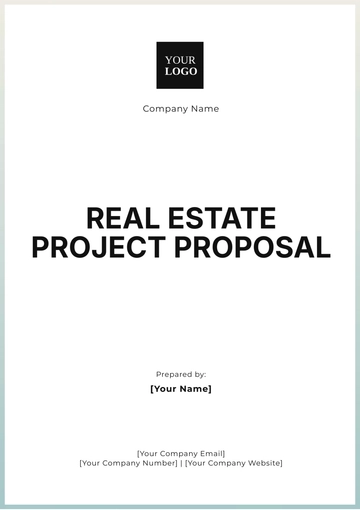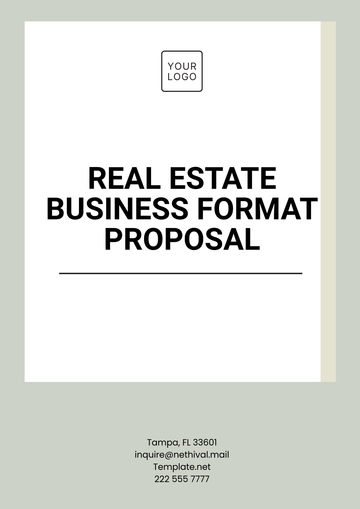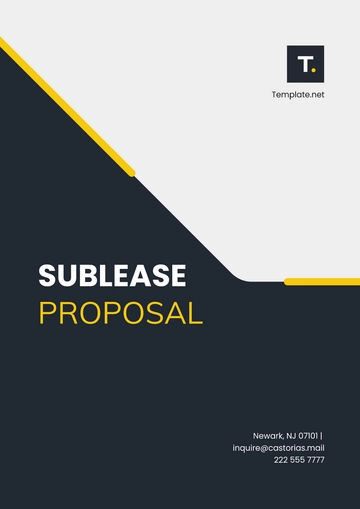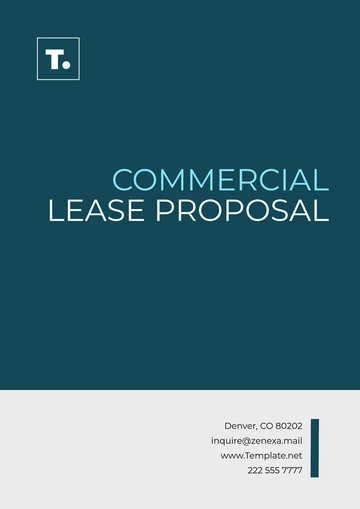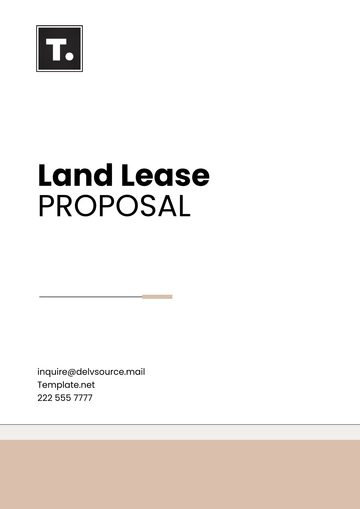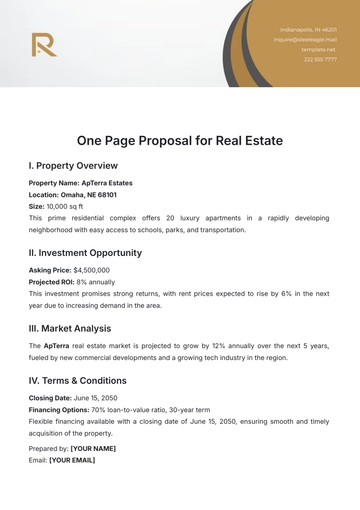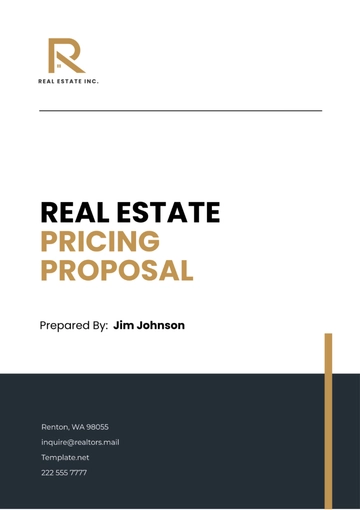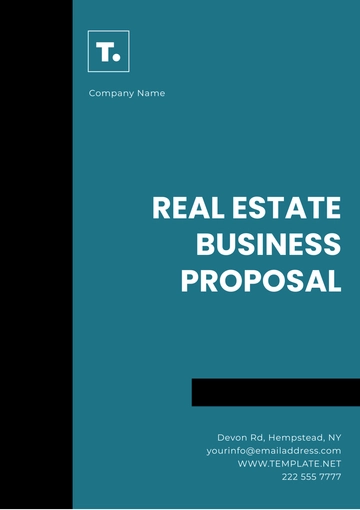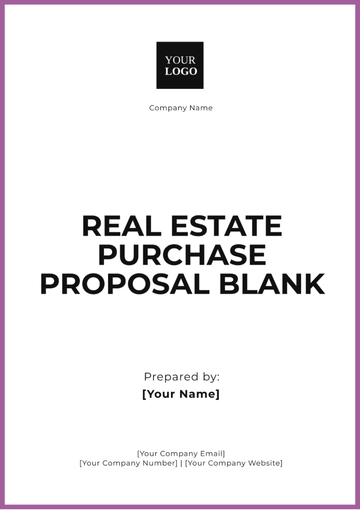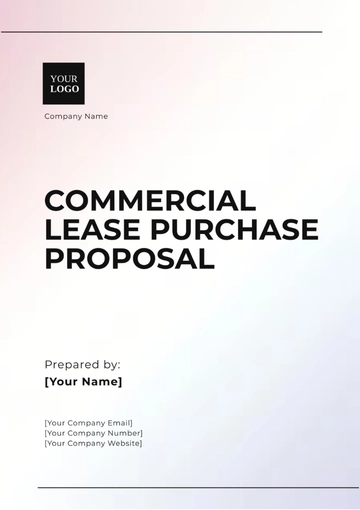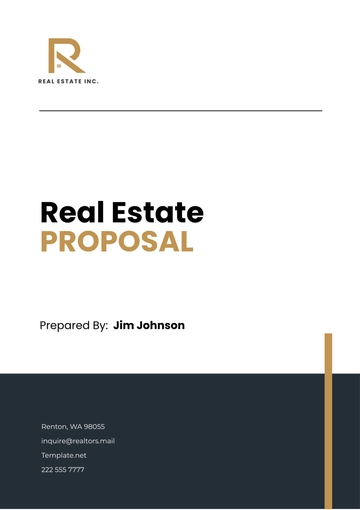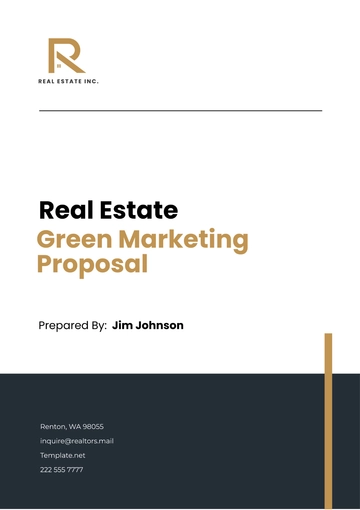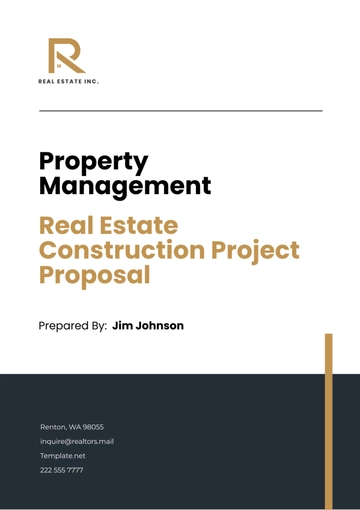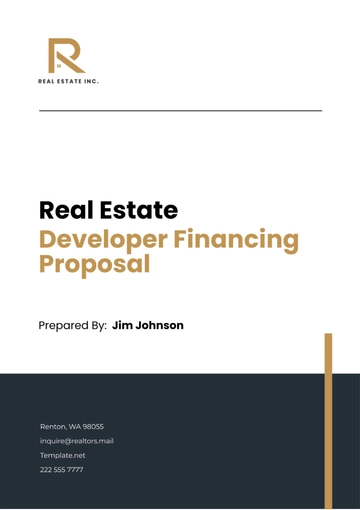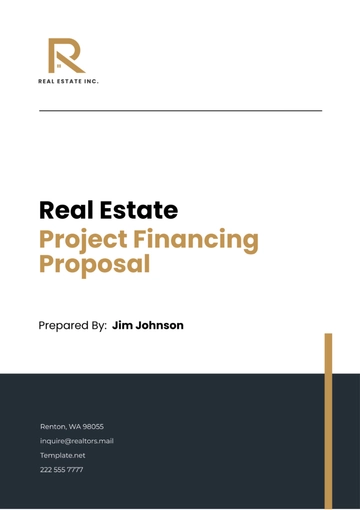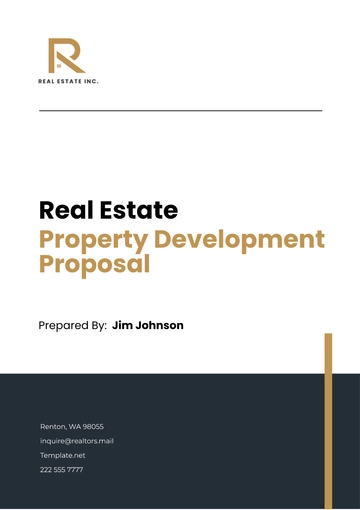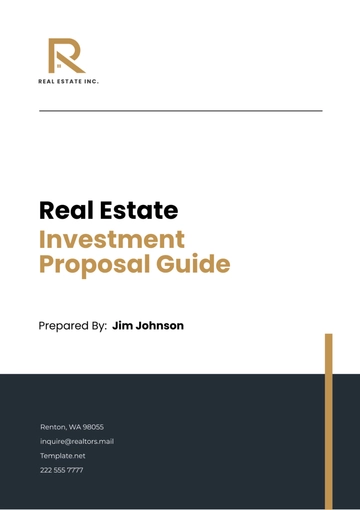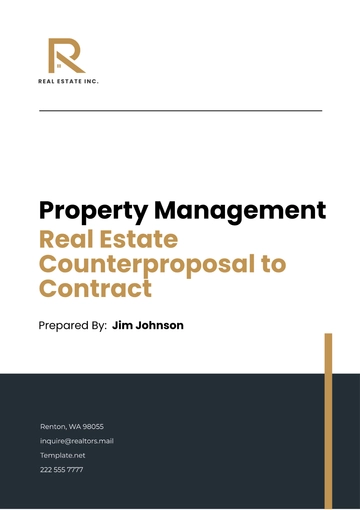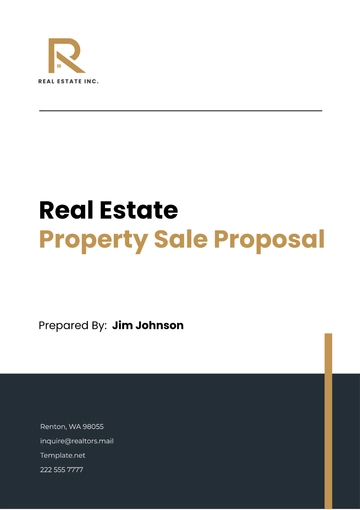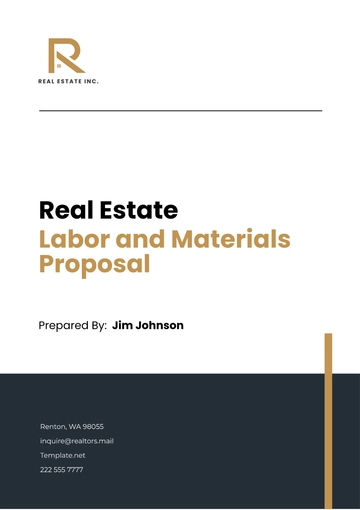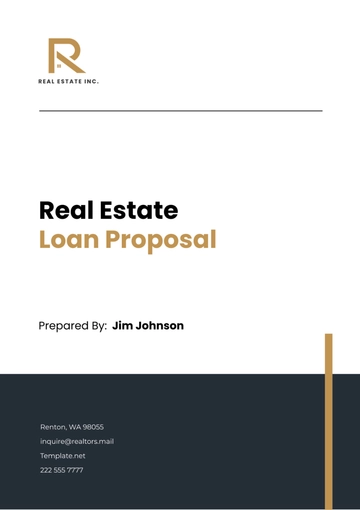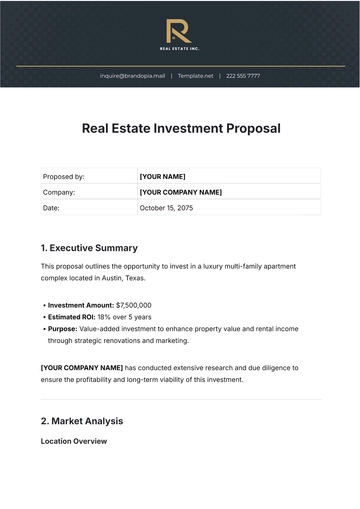Free Real Estate Investment Proposal Guide
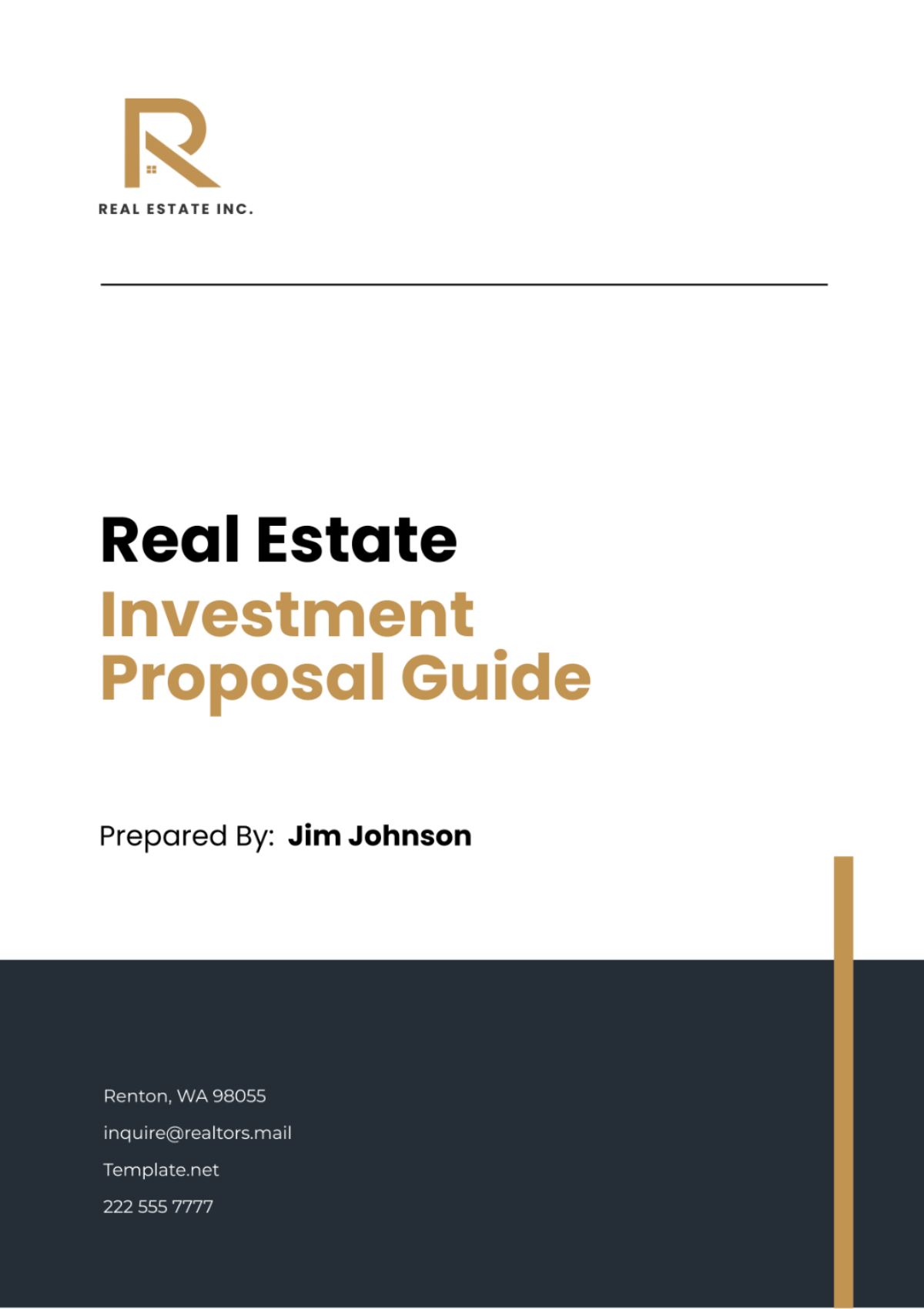
This guide outlines the steps, best practices, and crucial components to include when crafting a compelling real estate investment proposal for [Your Company Name]. Here, you will find all the necessary information neatly organized and arranged in a readable format.
I. Understanding the Investment Proposal
An investment proposal is the cornerstone of securing funding or partners for your real estate ventures. It is meticulously crafted to detail your project or property, highlight its value proposition, and reassure potential investors about the lucrative returns on their investment. Serving as a pivotal first step, it transforms your real estate vision into an actionable opportunity, presenting a clear, persuasive argument that underscores the uniqueness and profitability of your project.
Key Points:
Project Overview: At the heart of the investment proposal is a comprehensive overview of the project. This includes a detailed description of the property, its location, and the vision behind the real estate endeavor. The aim is to provide a solid foundation that paints a vivid picture of the project's scope and potential impact.
Value Proposition: The proposal elucidates the project's value proposition, highlighting how it stands out in the current market. It discusses the unique aspects of the property, the demand for such a project within the market, and how it aims to meet or exceed investor expectations in terms of both financial return and societal contribution.
Investor Reassurance: Finally, the proposal tackles the aspect of investor reassurance head-on. Through a well-thought-out presentation of financial forecasts, market analysis, and risk management strategies, it aims to build confidence among potential investors. This section assures them of the project's feasibility and the measures in place to mitigate risks, thereby securing their investment and trust in the venture's success.
II. Key Elements of a Winning Proposal
Crafting an effective real estate investment proposal for [Your Company Name] demands a deep understanding of what drives investor confidence and commitment. This section highlights the essential components that contribute to making your proposal not only compelling but also comprehensive, covering executive summary, market analysis, project details, financial projections, and risk assessment. Each element is designed to provide potential investors with a clear picture of the project's prospects, financial viability, and strategic risk management, ensuring your proposal stands out in a competitive landscape.
Executive Summary
Captivating Introduction: The executive summary serves as the gateway to your proposal, offering a succinct yet captivating introduction to the project. It should encapsulate the essence of the opportunity, emphasizing the unique selling points and the benefits awaiting investors. This segment sets the tone, inviting investors to delve deeper into the details of the proposal.
Market Analysis
Insightful Market Overview: An in-depth market analysis is crucial, providing investors with an understanding of the current landscape, trends, and the project's place within it. It involves a detailed examination of market dynamics, competitor analysis, and target demographic, highlighting the demand for the project and its potential for success in the identified market niche.
Project Details
Comprehensive Project Insights: This section delves into the specifics of the property, including its location, architectural plans, development phases, and unique features. It paints a detailed picture of the project, from concept to completion, illustrating its potential for income and appreciation, thereby reinforcing its attractiveness to investors.
Financial Projections
Robust Financial Forecasting: Financial projections are the backbone of the proposal, presenting detailed forecasts of revenue, expenses, and profitability. This includes cash flow projections, investment analysis, and expected returns, underpinned by realistic assumptions. It's designed to demonstrate the financial viability of the project, engaging investors by showcasing the potential for significant returns on their investment.
Risk Assessment
Strategic Risk Management: A thorough risk assessment addresses potential challenges and uncertainties, offering strategies to mitigate these risks. It covers market risks, construction risks, regulatory issues, and financial risks, among others. This section aims to build investor trust by transparently discussing potential obstacles and the proactive measures in place to protect the investment and ensure project success.
Incorporating these key elements into your proposal for [Your Company Name] will not only enhance its professionalism but also its persuasiveness. It demonstrates a well-rounded understanding of the project and the market, providing potential investors with the confidence needed to commit to your vision.
III. Structuring your Proposal
A well-structured real estate investment proposal is the linchpin in turning potential investor interest into commitment for [Your Company Name]. It should be meticulously organized to guide the reader through a compelling narrative, supported by visual aids and proof elements, and culminate in a strong call-to-action. This section outlines how to craft a proposal that is not only informative and comprehensive but also engaging and persuasive, ensuring that your project's story resonates with potential investors.
Crafting a Compelling Narrative
Engaging Storytelling: Begin with a narrative that draws investors in, weaving the project's vision, goals, and potential impact into a story that connects on a personal level. This narrative should highlight the uniqueness of the project and its significance in the market, making it not just another investment opportunity but a journey worth embarking on.
Utilizing Visuals
Visual Reinforcement: Enhance your narrative with visuals—graphs, charts, images of the property, and architectural renderings. These elements serve to break up text, making the proposal more digestible, and provide a visual representation of data and future visions, thereby making the investment opportunity more tangible and compelling to investors.
Including Proof Elements
Credibility through Proof: Bolster your proposal's credibility by including case studies of similar successful projects, testimonials from previous investors or partners, and any awards or recognitions. These proof elements serve to validate your claims about the project's potential and your capacity to deliver on promises, building trust with potential investors.
Call-to-Action
Motivating Action: Conclude with a clear, direct call-to-action that guides investors on what to do next. Whether it’s arranging a meeting, visiting the property site, or proceeding with an investment, the call-to-action should be unambiguous, motivating investors to take the next step towards involvement with your project.
By adhering to this structured approach, your proposal for [Your Company Name] will not only clearly communicate the value and potential of your real estate project but also engage and motivate potential investors to take action, moving closer to turning the project vision into reality.
IV. Example Proposal Format
Creating a structured and detailed format for your real estate investment proposal is crucial for presenting a compelling case to potential investors. Below is an example format for a proposal from [Your Company Name], designed to guide you through crafting a document that flows logically and captures the essence of your project effectively. This format uses a combination of narrative, analysis, financial data, and visuals to communicate the opportunity's value and potential returns.
Section | Subsection | Description |
|---|---|---|
1. Cover Page | - [Your Company Name] - Project Title - Image/Visual related to the project - Date | |
2. Table of Contents | - A detailed list of the proposal’s contents with page numbers | |
3. Introduction | a. Welcome Note | - Brief welcoming message and introduction to [Your Company Name] |
b. Proposal Objective | - Overview of the proposal’s purpose and what it seeks to achieve | |
4. Executive Summary | - Concise overview highlighting the project's potential, unique selling points, and the benefits for investors | |
5. Company Background | a. About [Your Company Name] | - History, mission, vision, and achievements of [Your Company Name] - Team overview highlighting expertise and experience |
b. Past Projects | - Summary of previous successful projects with outcomes and impacts | |
6. Market Analysis | a. Industry Overview | - Current state of the real estate market, trends, and forecasts |
b. Target Market | - Demographics, psychographics, and need analysis of the target market | |
c. Competitive Analysis | - Analysis of competitors, their strategies, strengths, and weaknesses | |
7. Project Details | a. Location & Accessibility | - Detailed information on the project location, surrounding infrastructure, and accessibility |
b. Project Overview | - Vision, scope, and unique features of the project | |
c. Development Plan | - Phased development plans, timelines, and milestones | |
8. Financial Projections | a. Investment Summary | - Initial investment required, funding structure, and use of funds |
b. Revenue Projections | - Detailed revenue forecasts, pricing strategy, and sales projections | |
c. Expense Projections | - Estimated project costs, operational expenses, and break-even analysis | |
d. ROI Analysis | - Return on Investment calculations and projections | |
9. Risk Assessment | - Identification of potential risks, mitigation strategies, and contingency plans | |
10. Appendices | a. Legal Documents | - Copies of relevant legal documents, licenses, and permits |
b. Architectural Plans | - Detailed architectural drawings and plans | |
c. Financial Tables | - Additional financial tables and analyses not included in the main text | |
11. Call to Action | - Clear directions on how investors can proceed, including contact information for arranging meetings or site visits |
V. Financial Analysis and Projections
The Financial Analysis and Projections section is pivotal in illustrating the economic viability and investment allure of your project. It provides a comprehensive breakdown of the financial facets, including initial investment needs, revenue forecasts, cash flow operations, and profitability analyses. By employing detailed tables and graphical representations, this section not only demonstrates a meticulous financial strategy but also underscores the project's potential for lucrative returns, thereby appealing directly to the investment rationale of potential backers.
Initial Investment Requirements
Capital Expenditure Breakdown: This component details the initial capital needed to kickstart the project, outlining costs related to land acquisition, construction, legal fees, and marketing. A table format is used to itemize and total these investments, providing a clear view of the startup financial needs.
Expected Revenue Streams
Income Forecasting: Here, the various sources of revenue for the project are identified and projected over time. This could include rental income, sales of units, or ancillary services. Charts illustrate the growth of these revenue streams, highlighting their contribution to the project's financial health.
Cash Flow Analysis
Operational Financial Flow: A cash flow statement is presented in this section, mapping out the inflow and outflow of funds on a monthly or yearly basis. It assesses the liquidity of the project, ensuring that operational needs can be met without financial strain.
Break-even Analysis
Cost-Recovery Projections: The break-even analysis identifies the point at which the project will start to generate profit, covering all initial and operational costs. This critical financial metric is visually represented, showing investors when they can expect the project to become financially sustainable.
Return on Investment (ROI) Calculations
Profitability Metrics: ROI calculations are detailed here, offering investors a clear picture of the potential returns against their initial investment. Using graphs, this section compares the projected ROI to industry benchmarks, positioning the project as a competitive investment opportunity.
VI. Sustainability and Environmental Impact
Embracing sustainability practices in your real estate project not only demonstrates [Your Company Name]'s commitment to environmental stewardship but also aligns with the growing demand for green investments. This section meticulously outlines the project's sustainability strategies, from energy-efficient design and construction to the use of eco-friendly materials. It highlights how these initiatives not only mitigate environmental impact but also offer operational cost savings, enhancing the project's appeal to investors who prioritize sustainability alongside profitability.
Energy-Efficient Construction and Design Methods
Innovative Building Techniques: This component elaborates on the application of cutting-edge, energy-efficient construction methods and design principles. It details the integration of technologies such as solar panels, green roofs, and smart building systems that significantly reduce energy consumption and carbon footprint.
Use of Sustainable Materials
Eco-Friendly Building Materials: Here, the focus is on the selection of sustainable materials for construction, emphasizing their benefits not just for the environment but for building longevity and health. It discusses the procurement of locally sourced, renewable, and recycled materials that contribute to a smaller ecological footprint.
Environmental Impact Assessments
Comprehensive Environmental Analysis: This part presents the results of thorough environmental impact assessments conducted to gauge the project's ecological implications. It includes considerations for land use, biodiversity, water management, and air quality, ensuring that the project complies with environmental regulations and best practices.
Long-term Sustainability Goals and Benchmarks
Future-Proofing the Project: The final subsection sets forth the project's long-term sustainability objectives and benchmarks. It outlines a roadmap for continuous improvement in environmental performance, detailing strategies for energy conservation, waste reduction, and the enhancement of green spaces, aiming for certifications like LEED or BREEAM.
VII. Legal and Regulatory Compliance
This segment meticulously outlines how the project aligns with zoning laws, adheres to all pertinent local, state, and federal regulations, secures necessary permits and licenses, and employs risk management strategies to ensure compliance. Demonstrating a thorough understanding and proactive approach to legal and regulatory obligations not only mitigates potential legal challenges but also reassures investors of the project’s integrity and viability.
Zoning and Land Use Regulations
Navigating Zoning Laws: This subsection provides a detailed analysis of how the project complies with local zoning and land use regulations. It describes the zoning classifications, land use permits, and any variances or exceptions obtained, ensuring that the project's development plan aligns with municipal land use strategies and policies.
Compliance with Local, State, and Federal Laws
Adhering to Legal Frameworks: Here, the proposal outlines the steps taken to ensure compliance with all applicable laws and regulations at the local, state, and federal levels. This includes environmental protection laws, building codes, accessibility standards, and any specific legislation relevant to the project's nature and location, demonstrating a commitment to lawful and ethical development practices.
Permits and Licenses Required
Securing Official Approvals: This part details the range of permits and licenses required for the project, from construction and environmental impact permits to operational licenses. It not only lists these requirements but also provides statuses or timelines for obtaining them, showcasing the project's readiness and legal diligence.
Risk Management Strategies Related to Legal Compliance
Mitigating Compliance Risks: The final subsection emphasizes the risk management strategies implemented to address potential legal and regulatory compliance issues. It discusses the establishment of compliance monitoring systems, regular legal audits, and the engagement of legal experts to navigate complex regulatory landscapes, ensuring that the project minimally risks legal entanglements.
Incorporating a comprehensive review of legal and regulatory compliance into your proposal illustrates [Your Company Name]'s proactive and meticulous approach to addressing potential legal hurdles. By transparently presenting how the project navigates the complexities of real estate development regulations, your proposal builds confidence among investors, highlighting your commitment to delivering a legally sound and viable real estate venture.
- 100% Customizable, free editor
- Access 1 Million+ Templates, photo’s & graphics
- Download or share as a template
- Click and replace photos, graphics, text, backgrounds
- Resize, crop, AI write & more
- Access advanced editor
At Template.net, we present our Real Estate Investment Proposal Guide Template. This editable, customizable tool is editable in our Ai Editor Tool, designed to breathe life into your property investing dreams. With our template, create impactful proposals swiftly yet with precision. Transform your real estate investment journey today - a proposal that impresses is a deal half closed.
You may also like
- Business Proposal
- Research Proposal
- Proposal Request
- Project Proposal
- Grant Proposal
- Photography Proposal
- Job Proposal
- Budget Proposal
- Marketing Proposal
- Branding Proposal
- Advertising Proposal
- Sales Proposal
- Startup Proposal
- Event Proposal
- Creative Proposal
- Restaurant Proposal
- Blank Proposal
- One Page Proposal
- Proposal Report
- IT Proposal
- Non Profit Proposal
- Training Proposal
- Construction Proposal
- School Proposal
- Cleaning Proposal
- Contract Proposal
- HR Proposal
- Travel Agency Proposal
- Small Business Proposal
- Investment Proposal
- Bid Proposal
- Retail Business Proposal
- Sponsorship Proposal
- Academic Proposal
- Partnership Proposal
- Work Proposal
- Agency Proposal
- University Proposal
- Accounting Proposal
- Real Estate Proposal
- Hotel Proposal
- Product Proposal
- Advertising Agency Proposal
- Development Proposal
- Loan Proposal
- Website Proposal
- Nursing Home Proposal
- Financial Proposal
- Salon Proposal
- Freelancer Proposal
- Funding Proposal
- Work from Home Proposal
- Company Proposal
- Consulting Proposal
- Educational Proposal
- Construction Bid Proposal
- Interior Design Proposal
- New Product Proposal
- Sports Proposal
- Corporate Proposal
- Food Proposal
- Property Proposal
- Maintenance Proposal
- Purchase Proposal
- Rental Proposal
- Recruitment Proposal
- Social Media Proposal
- Travel Proposal
- Trip Proposal
- Software Proposal
- Conference Proposal
- Graphic Design Proposal
- Law Firm Proposal
- Medical Proposal
- Music Proposal
- Pricing Proposal
- SEO Proposal
- Strategy Proposal
- Technical Proposal
- Coaching Proposal
- Ecommerce Proposal
- Fundraising Proposal
- Landscaping Proposal
- Charity Proposal
- Contractor Proposal
- Exhibition Proposal
- Art Proposal
- Mobile Proposal
- Equipment Proposal
- Student Proposal
- Engineering Proposal
- Business Proposal
